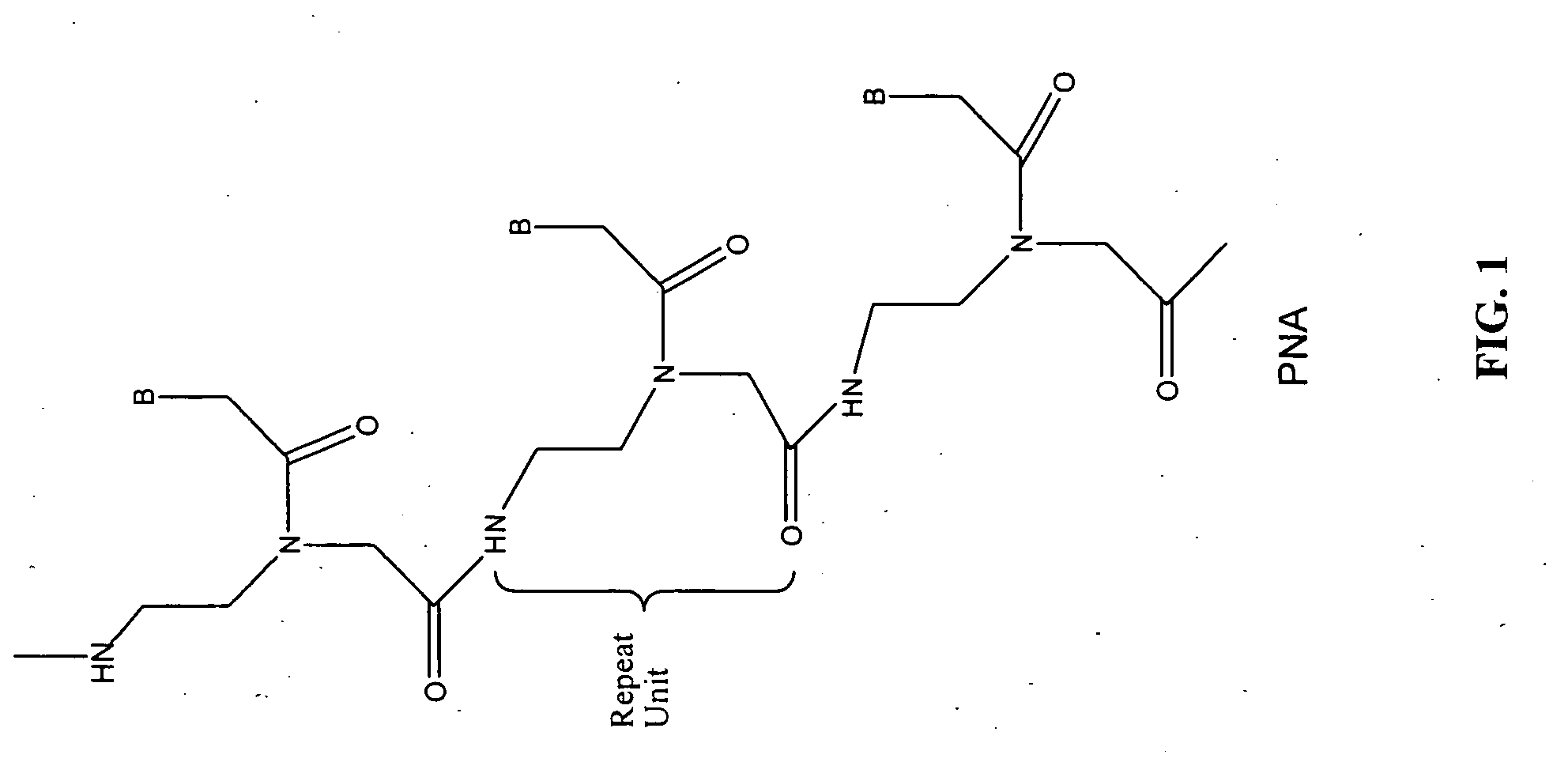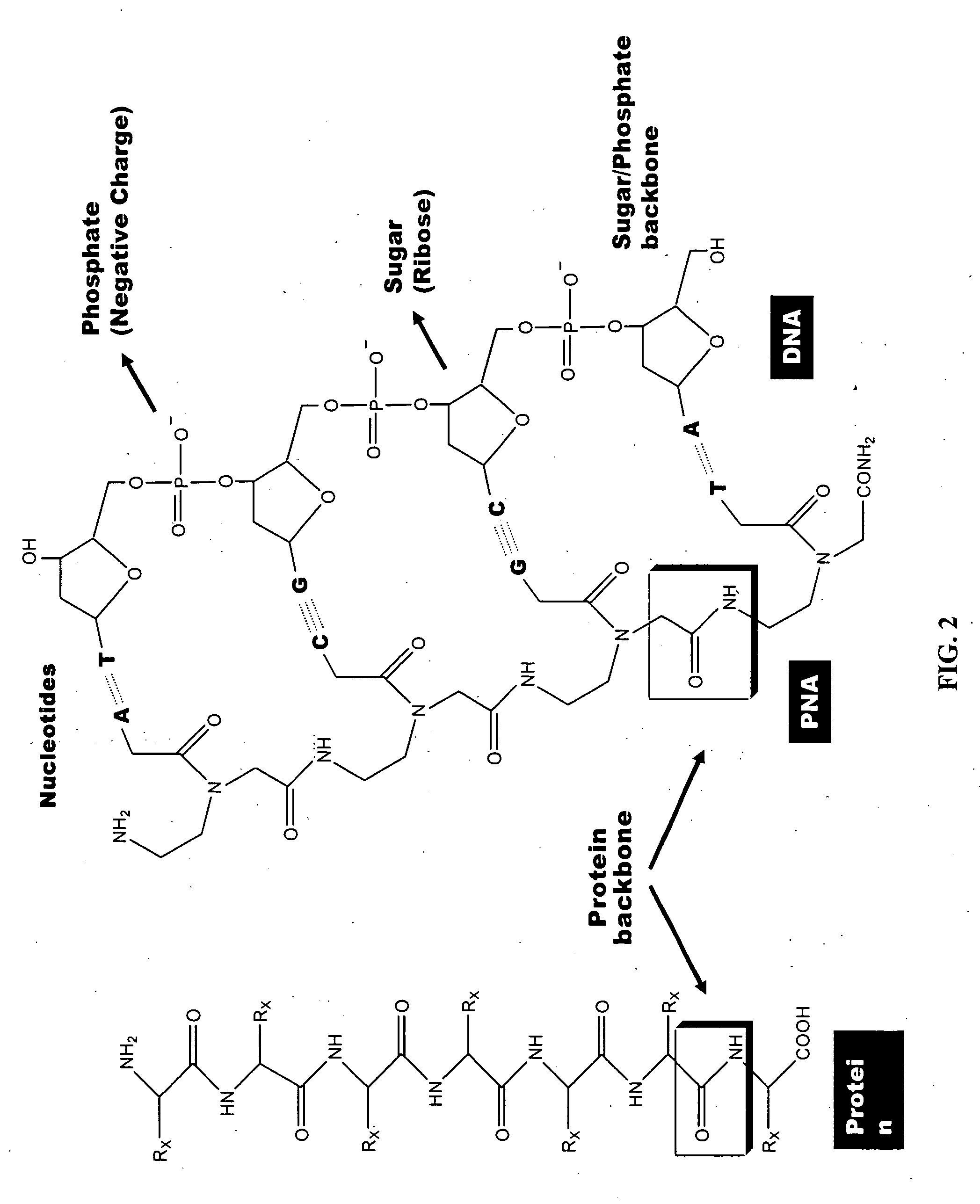PNA-DNA oligomers and methods of use thereof
a technology of oligomers and primers, applied in the field of oligomers, can solve the problems of high ineffectiveness of oligomers (e.g., primers) in these conditions, or fail altogether, and achieve the effects of improving methods effectiveness, rapid and reliable detection of nucleic acids, and greater binding affinity for nucleic acids
- Summary
- Abstract
- Description
- Claims
- Application Information
AI Technical Summary
Benefits of technology
Problems solved by technology
Method used
Image
Examples
example 1
Real-Time Quantitative Polymerase Chain Reaction (QPCR)
[0162]Amplification efficiency varies greatly during the early cycles of polymerase chain reaction (PCR) and improvement of early stage amplification yields an earlier cycle threshold value. Primer binding, primer stability and the number of fully extended PCR products governs the success of PCR. A number of factors, including the stability of primer-nucleic acid binding and PCR reagent concentrations (e.g., DNA polymerase, primers, MgCl2) control primer binding. Consequently, increasing the thermal stability of primers and reducing their susceptibility to degradation may improve early stage amplification by improving the efficiency of PCR.
Experimental Design. PNA-DNA oligomers and DNA primers were tested under a wide range of standard PCR conditions to determine their relative efficiency in amplifying target Bacillus anthracis DNA. The virulence plasmid of Bacillus anthracis (Anthrax), pX01 was chosen as the target DNA for the ...
example 2
QPCR Under Different Sample Conditions
[0166]Rapid identification and quantification of DNA in environmental samples is difficult at best. Primer binding in the presence of salts and primer stability in the presence of enzymes that degrade DNA limit successful detection using QPCR. PNA-DNA oligomers that are less dependent on ionic strength for binding to template DNA strands than DNA primers and are stable in the presence of enzymes. Faster thermal cycling would have a great impact on the speed of product detection using QPCR, an important step in reaching the ultimate goal of instant quantitative product detection.
Experimental design. A known concentration of target DNA was added to varying dilutions of experimental samples to ascertain the effect of environmental inhibitors on target DNA detection by PNA-DNA oligomers and DNA primers. Even at high dilutions, environmental samples often contain sufficient inhibitors to eliminate QPCR amplification of target DNA. DNA primers and flu...
example 3 pna-dna
Oligomer Design
[0169]Unlike the case for DNA primer design, no commercially available programs exist for PNA / DNA chimeric primer design. A computer program was written in MATLAB that locates forward and reverse PNA-DNA oligomer binding sites. From the possible forward and reverse PNA binding sites, a PNA-DNA oligomer and probes were selected by hand from 181,677 base pairs of the B. anthracis plasmid, pXO1 by searching for sequences matching the aforementioned constraints.
[0170]Based on experiments performed with PNA-DNA oligomers and labeled probes in QPCR (see FIGS. 19A and 19B), parameters for identifying and / or optimizing PNA-DNA oligomers and / or DNA probes for a target nucleic acid were developed. The parameters of the algorithm are as follows:
PNA-DNA Oligomers (Forward and Reverse PCR Primers)
[0171]Guanine (G) and cytosine (C) nucleotide content (GC content) of between 30% and 80%.[0172]Melting temperature of between 54° C. and 64° C.[0173]Adenine (A) and thymine (T) nucleotid...
PUM
| Property | Measurement | Unit |
|---|---|---|
| melting temperature | aaaaa | aaaaa |
| melting temperature | aaaaa | aaaaa |
| melting temperature | aaaaa | aaaaa |
Abstract
Description
Claims
Application Information
 Login to View More
Login to View More - R&D
- Intellectual Property
- Life Sciences
- Materials
- Tech Scout
- Unparalleled Data Quality
- Higher Quality Content
- 60% Fewer Hallucinations
Browse by: Latest US Patents, China's latest patents, Technical Efficacy Thesaurus, Application Domain, Technology Topic, Popular Technical Reports.
© 2025 PatSnap. All rights reserved.Legal|Privacy policy|Modern Slavery Act Transparency Statement|Sitemap|About US| Contact US: help@patsnap.com



